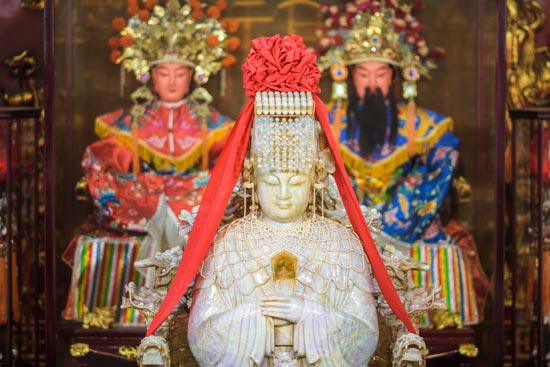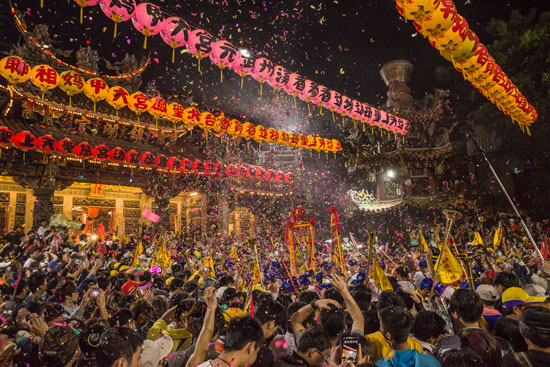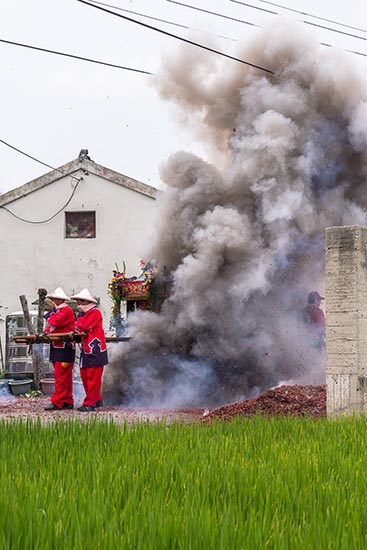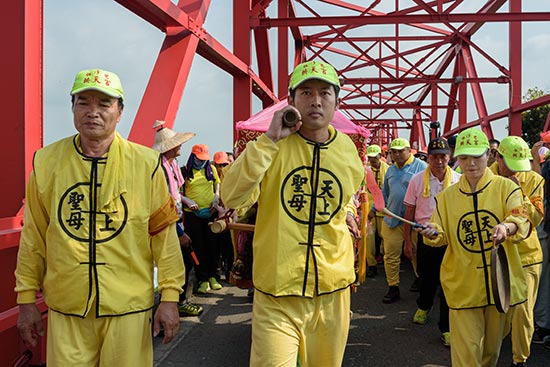Gods of Taiwan
Celebrating the Birthday of Mazu (Matsu, 媽祖)

Mazu Statue in DaJia Zhen Lan Temple
As Taiwan's most worshipped deity, the birthday of the goddess Mazu is a busy and important period in Taiwanese religion. She is believed to have been born on the 23rd day of the third month in the Chinese lunar calendar, which corresponds to a different date each year in the western calendar but is around the end of April or start of May. Celebrations for her birthday are numerous and vary hugely in scale, and are spread around a month or two before and after this date. The three largest and best known of these ceremonies are from the towns of Dajia (Da Jia, 大甲), Beigang (Peigang, 北港) and Baishatun (Bai Sha Tun, 白沙屯).
Da Jia Mazu (大甲媽祖)
The most famous Mazu pilgrimage, and the one with the largest number of devotees, starts at Zhen Lan temple (鎮瀾宮) in Dajia, Taichung county, in the third month of the lunar calendar. The ceremony usually starts on a Friday evening, because it has become a major arts and performance festival too, but the week and time is divined from Mazu's wishes by casting moon blocks. The beginning of the pilgrimage involves various performance troupes such as lion dancers entertaining the goddess and huge crowd outside the temple, whilst inside water is blessed under the palanquin carrying the image of Mazu and given out to devotees. Finally, Mazu makes her way out of the temple, surrounded by many thousands of worshippers, with fireworks exploding above. After leaving DaJia, the parade passes over the long bridge leading to Taichung city, from which a further huge fireworks display can be seen, and the 9 day tour begins.

Start of the Dajia Mazu Festival
From DaJia, the Mazu palanquin is carried on foot a total of 330 kilometres, before returning to Zhen Lan temple. The halfway point, and furthest South on the pilgramage, is the Mazu temple of Feng Tian in Xingang, Chiayi county, not far from Beigang, the site of another major Mazu festival.
Due to the length of the journey, all completed on foot, no troupes accompany the palanquin for the entire pilgrimage. However, along the way local temples will send troupes and their own Mazu statues inside palanquins to join DaJia's Mazu for parts of her trip - always with DaJia's Mazu at the rear of the parade, as befitting her high status. Initially, Mazu did not go through the city of Changhua as part of her route, and local gangs would often try to attack the parade and steal the palanquin to take it to their temple or area, believing it to bring them luck. As a result, the organisers asked Mazu if they should avoid the city, drive through it, or walk through, and she directed them to do the latter. Even now though, Changhua is notorious for gangs and groups of devotees fighting to hijack the parade and take the palanquin to their parts of the city, and the palanquin is usually carried through the city by police to try to deter this.
Most palanquins in temple tours are carried by designated temple officials or groups, wearing the temple uniform. However, while the DaJia Mazu procession does have such uniformed people, on many parts of the tour (particularly the more rural), anyone can be allowed to help carry her.
Beigang Mazu (北港媽祖)

Eating the gun in Beigang
Unlike the festivals from Dajia and Baisatun, which are long pilgrimages over long distances, the Mazu festival from Chaotian temple (朝天宫, Chao Tian Gong) in Beigang near Chayi City focusses on touring the town itself. As a result it is shorter (in theory two days but always running into the third) and contains a variety of troupes for the duration. The main procession includes a palanquin carried by local children for the child god San Ti Zi, another palanquin for the tiger god Hu Ye, and six more for statues of Mazu. One special feature of Beigang processions is the exploding of huge piles of firecrackers underneath the palanquins, while the palanquin bearers stand around, a practice called Chi Pao (吃砲), 'eating the gun'.
During the festival, some of the more than 300 temples that consider Chao Tian Temple their ancestral temple visit Beigang to pay their respects, and so in addition to the main parade, a large variety of temple troupes and groups can be seen lining up to visit the temple. This is a great opportunity to witness a large range of performers and rituals, including Tang Ki, Ba Jia Jiang and Guan Jiang Shou. These activities continue after the procession from the main temple has finished, usually on the morning of the third day of the festival.
Baisatun Mazu (白沙屯媽祖)

Baisatun Mazu Pilgrimage
Baisatun Mazu's annual pilgrimage starts from Gongtian Temple (拱天宮) in western Miaoli County, and travels several days before arriving at Beigang Chao Tian temple, it's ancestral temple. As the crow flies the two temples are almost 120km apart, but the distance walked varies, as the route and timing are decided by Mazu herself. Every year before Mazu's birthday, temple officials will cast moon blocks to determine the starting and arrival days for the procession. In addition, while walking the palanquin will often stop, a gong is hit and the palanquin will sway side to side. The lead palanquin bearer will then know which direction Mazu wishes to take, which means that the route is different every year, and often involves the goddess being carried through fields or supermarkets.
The Baisatun pilgrimage, as with the one from Dajia, attracts a huge number of followers, who accompany Mazu's palanquin for part, or all of the long journey. For a small fee, followers can register in advance, and receive a distinctive orange cap and armband. Followers of Taiwan's tradditional religion believe that offering food and drink to those taking part in ceremonies and pilgrimages will bring good luck, and so wearing the cap and armband brings constant offers of free refreshments from locals at the side of the road, as well as creating a beautiful sea of orange wherever the palanquin goes.
Next: King Boat